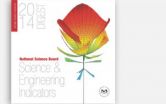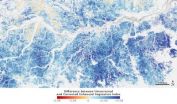(Press-News.org) A team of researchers, led by scientists at Case Western Reserve University, has developed a multifunctional nanoparticle that enables magnetic resonance imaging (MRI) to pinpoint blood vessel plaques caused by atherosclerosis. The technology is a step toward creating a non-invasive method of identifying plaques vulnerable to rupture–the cause of heart attack and stroke—in time for treatment.
Currently, doctors can identify only blood vessels that are narrowing due to plaque accumulation. A doctor makes an incision and slips a catheter inside a blood vessel in the arm, groin or neck. The catheter emits a dye that enables X-rays to show the narrowing.
However, Case Western Reserve researchers report online today in the journal Nano Letters that a nanoparticle built from a rod-shaped virus commonly found on tobacco locates and illuminates plaque in arteries more effectively and with a tiny fraction of the dye.
More importantly, the work shows that the tailored nanoparticles home in on plaque biomarkers. That opens the possibility that particles can be programmed to identify vulnerable plaques from stable, something untargeted dyes alone cannot.
"From a chemist's point of view, it's still challenging to make nanoparticles that are not spherical, but non-spherical materials are advantageous for medical applications" said Nicole F. Steinmetz, assistant professor of biomedical engineering at Case Western Reserve. "Nature is way ahead of us. We're harvesting nature's methods to turn them into something useful in medicine."
The rod-shaped nanoparticles are made from tobacco mosaic virus, tiny tubular organisms that infect plant cells but are benign outside the plant.
Steinmetz, a specialist in bioengineering plant viruses, teamed with Xin Yu, a professor of biomedical engineering, who specializes in developing MRI techniques to investigate cardiovascular diseases. They created a device that transports and concentrates imaging agents on plaques.
The research team includes: Michael A. Bruckman, a postdoctoral researcher, and Lauren N. Randolph, an undergraduate student, in the Steinmetz lab; Kai Jiang, a PhD student in Yu's lab; and Leonard G. Luyt, assistant professor, and Emily J. Simpson, a PhD candidate, both at department of chemistry at Western University, in London, Ontario.
Elongated nanoparticles have a higher probability of being pushed out of the central blood flow and targeting the vessel wall compared to spheres. Further the shape allows more stable attachment to the plaque, the researchers said.
The virus surface is modified to carry short chains of amino acids, called peptides, that make the virus stick where plaques are developing or already exist. Luyt and Simpson synthesized the peptides.
"The binding allows the particle to stay on the site longer, whereas the sheer force is more likely to wash away a sphere, due to its high curvature," said Yu, an appointee of the Case School of Engineering.
The virus surface was also modified to carry near-infrared dyes used for optical scanning, and gadolinium ions (which are linked with organic molecules, to reduce toxicity of the metal) used as an MRI contrasting agent. They used optical scans to verify the MRI results.
By loading the surface with gadolinium ions instead of injecting them and letting them flow freely in the blood stream, the nanoparticle increases the relaxivity—or contrast from healthy tissue—by more than four orders of magnitude.
"The agent injected in the blood stream has a relaxivity of 5, and our nanoparticles a relaxivity of 35,000," said Steinmetz who was appointed by the Case Western Reserve School of Medicine.
That's because the nanorod carries up to 2,000 molecules of the contrast agent, concentrating them at the plaque sites. Secondly, attaching the contrast agent to a nanoparticle scaffold reduces its molecular tumbling rates and leads to additional relaxivity benefit, the researchers explained.
While the view is better, they are able to use 400 times less of the contrast agent because it's delivered directly to plaques.
The tobacco virus-based nanoparticle, they said, offers another advantage: Most nanoparticles that have been developed to carry contrast agents are based on synthetic materials, some of which may stay in the body a while.
The tobacco virus is made of protein, which the body is well equipped to handle and flush from the system rapidly.
Steinmetz and Yu, members of the Case Center for Imaging Research, are now proposing to take the work a step further. They want to tailor the nanoparticles to show doctors whether the plaques are stable and require no treatment, or are vulnerable to rupture and require treatment. A rupture sets off the cascade of events that lead to heart attack and stroke.
To do this, they must first find different biomarkers of stable versus vulnerable plaques and coat the nanoparticles with different peptides and contrast agents that enable the MRI to tell one from the other.
"Our understanding of vulnerable plaques is incomplete, but once we can diagnose vulnerable plaques from stable plaques, it will be a paradigm shift in diagnosis and prognosis," Yu said.
In addition to using the technology to find vulnerabilities, it may also useful for delivering medicines and monitoring treatment, the researchers say.
INFORMATION: END
Nanoparticle pinpoints blood vessel plaques
A step toward indentifying plaques vulnearble to rupture and cause heart attack and stroke
2014-02-06
ELSE PRESS RELEASES FROM THIS DATE:
Loose coupling between calcium channels and sensors
2014-02-06
This news release is available in German. Information transmission at the synapse between neurons is a highly complex, but at the same time very fast, series of events. When a voltage change, the so-called action potential, reaches the synaptic terminal in the presynaptic neuron, calcium flows through voltage-gated calcium channels into the presynaptic neuron. This influx leads to a rise in the intracellular calcium concentration. Calcium then binds to a calcium sensor in the presynaptic terminal, which in turn triggers the release of vesicles containing neurotransmitters ...
US lead in science and technology shrinking
2014-02-06
The United States' (U.S.) predominance in science and technology (S&T) eroded further during the last decade, as several Asian nations--particularly China and South Korea--rapidly increased their innovation capacities. According to a report released today by the National Science Board (NSB), the policy making body of the National Science Foundation (NSF) and an advisor to the President and Congress, the major Asian economies, taken together, now perform a larger share of global R&D than the U.S., and China performs nearly as much of the world's high-tech manufacturing as ...
Prickly protein
2014-02-06
A genetic mechanism that controls the production of a large spike-like protein on the surface of Staphylococcus aureus (staph) bacteria alters the ability of the bacteria to form clumps and to cause disease, according to a new University of Iowa study.
The new study is the first to link this genetic mechanism to the production of the giant surface protein and to clumping behavior in bacteria. It is also the first time that clumping behavior has been associated with endocarditis, a serious infection of heart valves that kills 20,000 Americans each year. The findings were ...
NASA study points to infrared-herring in apparent Amazon green-up
2014-02-06
For the past eight years, scientists have been working to make sense of why some satellite data seemed to show the Amazon rain forest "greening-up" during the region's dry season each year from June to October. The green-up indicated productive, thriving vegetation in spite of limited rainfall.
Now, a new NASA study published today in the journal Nature shows that the appearance of canopy greening is not caused by a biophysical change in Amazon forests, but instead by a combination of shadowing within the canopy and the way that satellite sensors observe the Amazon during ...
Valentine's Day advice: Don't let rocky past relations with parents spoil your romance
2014-02-06
University of Alberta relationship researcher Matt Johnson has some Valentine's Day advice for anybody who's had rocky relations with their parents while growing up: don't ...
Falcon feathers pop-up during dive
2014-02-06
Similar to wings and fins with self-adaptive flaps, the feathers on a diving peregrine falcon's feathers may pop-up during high speed dives, according to a study published in PLOS ONE on February 5, 2014 by Benjamin Ponitz from the Institute of Mechanics ...
New, high-tech prosthetics and orthotics offer active life-style for users
2014-02-06
TAMPA, Fla. (Feb. 5, 2014) – Thanks to advanced technologies, those who wear prosthetic and orthotic devices ...
University of Montana research shows converting land to agriculture reduces carbon uptake
2014-02-06
MISSOULA – University of Montana researchers examined the impact that converting natural land to cropland has on global vegetation growth, as measured by satellite-derived ...
Bacterial fibers critical to human and avian infection
2014-02-06
Escherichia coli—a friendly and ubiquitous bacterial resident in the guts of humans and other animals—may occasionally colonize regions outside the intestines. There, it can have serious consequences for health, ...
Study suggests whole diet approach to lower CV risk has more evidence than low-fat diets
2014-02-06
Philadelphia, PA, February 5, 2014 – A study published in The American Journal of Medicine ...
LAST 30 PRESS RELEASES:
Sports injuries sustained during your period might be more severe
World's first successful 2 Tbit/s free-space optical communication using small optical terminals mountable on satellites and HAPS
Can intimate relationships affect your heart? New study says ‘yes’
Scalable and healable gradient textiles for multi‑scenario radiative cooling via bicomponent blow spinning
Research shows informed traders never let a good climate crisis go to waste
Intelligent XGBoost framework enhances asphalt pavement skid resistance assessment
Dual-function biomaterials for postoperative osteosarcoma: Tumor suppression and bone regeneration
New framework reveals where transport emissions concentrate in Singapore
NTP-enhanced lattice oxygen activation in Ce-Co catalysts for low-temperature soot combustion
Synergistic interface engineering in Cu-Zn-Ce catalysts for efficient CO2 hydrogenation to methanol
COVID-19 leaves a lasting mark on the human brain
Scientists use ultrasound to soften and treat cancer tumors without damaging healthy tissue
Community swimming program for Black youth boosts skills, sense of belonging, study finds
Specific depressive symptoms in midlife linked to increased dementia risk
An ‘illuminating’ design sheds light on cholesterol
Who is more likely to get long COVID?
Study showcases resilience and rapid growth of “living rocks”
Naval Research Lab diver earns Office of Naval Research 2025 Sailor of the Year
New Mayo-led study establishes practical definition for rapidly progressive dementia
Fossil fuel industry’s “climate false solutions” reinforce its power and aggravate environmental injustice
Researchers reveal bias in a widely used measure of algorithm performance
Alcohol causes cancer. A study from IOCB Prague confirms damage to DNA and shows how cells defend against it
Hidden viruses in wastewater treatment may shape public health risks, study finds
Unlock the power of nature: how biomass can transform climate mitigation
Biochar reshapes hidden soil microbes that capture carbon dioxide in farmland
Reducing saturated fat intake shows mortality benefit, but only in high-risk individuals
Manta rays create mobile ecosystems, study finds
Study: Mixed results in using lipoic acid to treat progressive multiple sclerosis
Norbert Holtkamp appointed director of Fermi National Accelerator Laboratory
New agentic AI platform accelerates advanced optics design
[Press-News.org] Nanoparticle pinpoints blood vessel plaquesA step toward indentifying plaques vulnearble to rupture and cause heart attack and stroke



